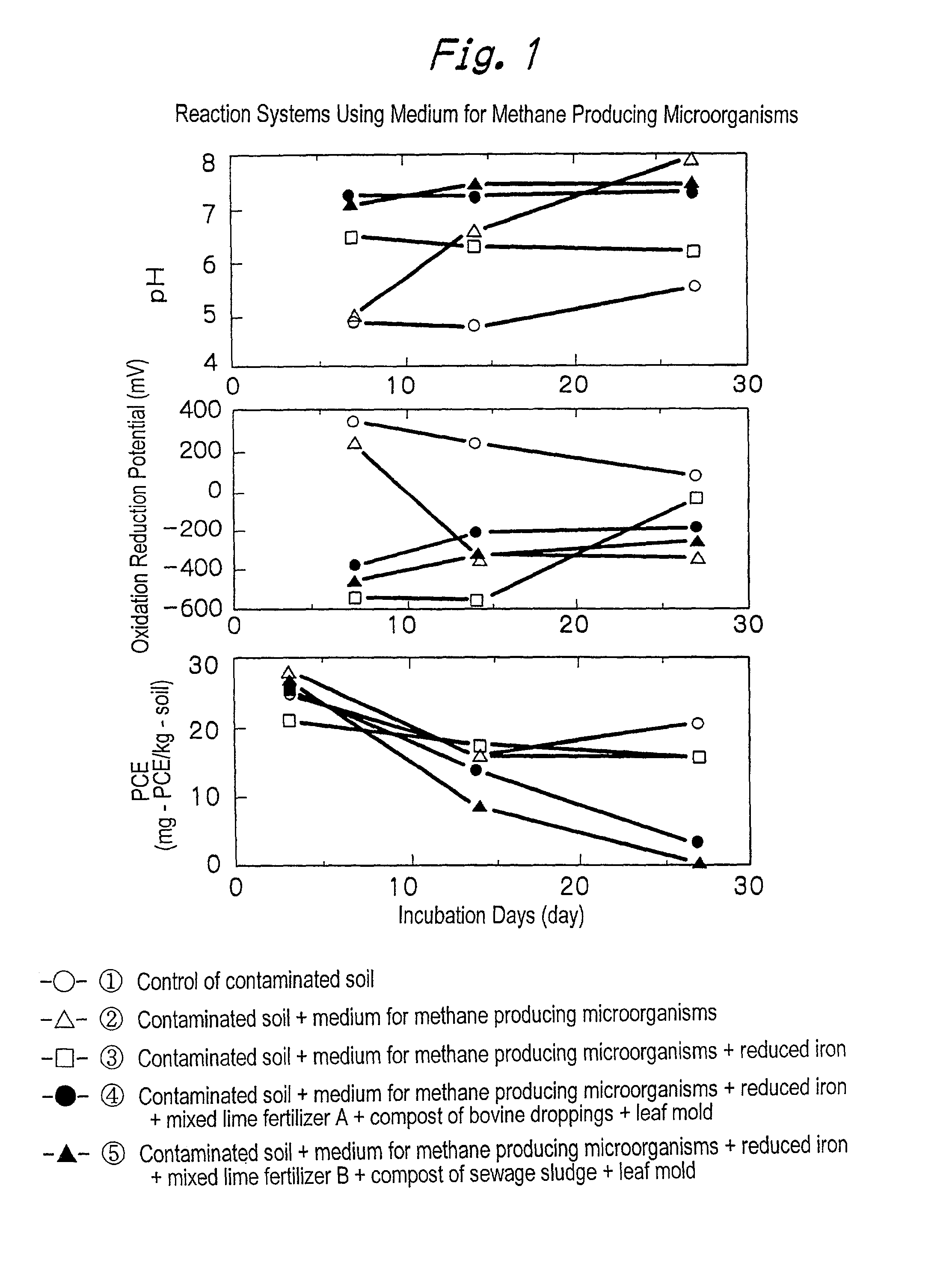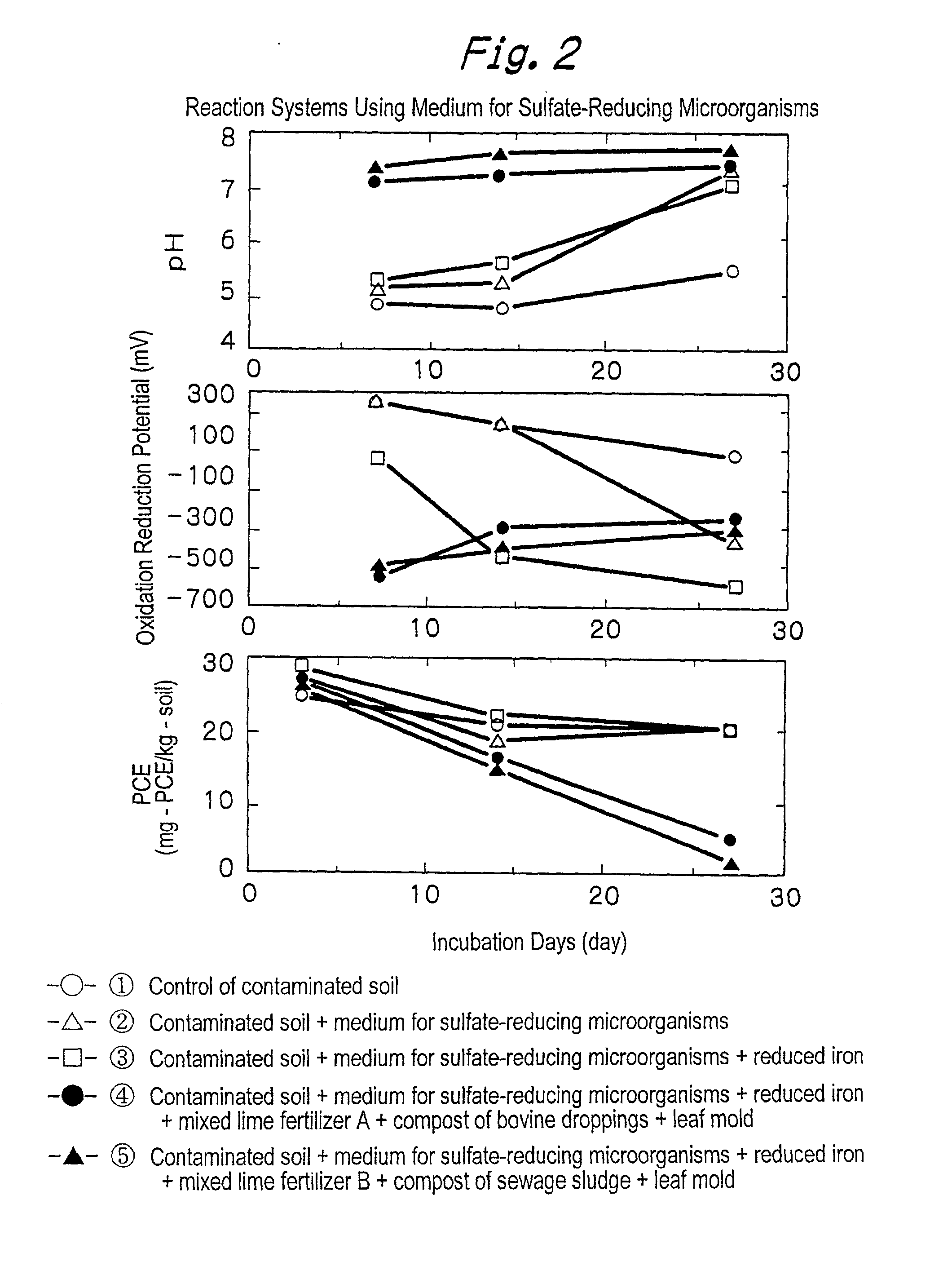Method for purifying matter contaminated with halogenated organic compounds
a technology of halogenated organic compounds and purification methods, which is applied in the direction of chemistry apparatus and processes, separation processes, biological water/sewage treatment, etc., can solve the problems of limiting the kinds and concentrations of substances that can be decomposed, halogenated organic compounds are not readily decomposable in the natural world, and are hardly soluble in water
- Summary
- Abstract
- Description
- Claims
- Application Information
AI Technical Summary
Benefits of technology
Problems solved by technology
Method used
Image
Examples
example 1
[0140] In Example 1, a powder of the reduced iron was used as the reducing agent.
[0141] A contaminated soil collected from a surface layer of contaminated soil in a factory A was used. The contaminant in the contaminated soil was mainly tetrachloroethylene, and 25 mg of tetrachloroethylene was present in 1 kg of dry contaminated soil. 30 gram of the contaminated soil was added to each of fourteen vials of a volume of 125 ml. The 14 samples were tested under 14 different experimental conditions, and changes over a period were determined concerning pH of the contaminated soil, an oxidation reduction potential with respect to the saturated silver chloride electrode thereof, and a decrease in tetrachloroethylene. The water content of each test system ranges from 48 to 53 percent. During the preparation of the sample in each vial and after collecting the sample in the vial, the gas phase of the vial was replaced with a nitrogen gas.
[0142] The contaminated soil samples originated from a l...
example 2
[0171] In Example 2, a powder of the reduced iron was used as the reducing agent. In control, iron (II) chloride or iron (II) sulfate was used.
[0172] To the tetrachloroethylene contaminated soil collected from the factory A as in Example 1 was added tetrachloroethylene to adjust a final concentration of tetrachloroethylene of about 75 milligram per 1 kg of the dry soil. Similar to Example 1, 30 gram of the contaminated soil was added to each of vials of a volume of 125 ml. The samples were tested under 8 different experimental conditions, and changes over a period were determined concerning pH of the contaminated soil, an oxidation reduction potential with respect to the saturated silver chloride electrode thereof, and a decrease in tetrachloroethylene. The water content of each test system ranges from 48 to 53 percent. In reaction systems A-4 and B-4, the contaminated soil, compost of sewage sludge and leaf mold were sterilized with steam in an autoclave for 60 minutes, thereby ste...
example 3
[0192] In Example 3, the reduced iron was used as the reducing agent.
[0193] Sludge samples, X and Y, were collected from a bottom of a lake and from a surface of swamp, respectively. The lake and the swamp are adjacent to an industrial area. Tetrachloroethylene was added to the sludge samples to adjust a final concentration of 35 milligram of tetrachloroethylene in 1 kg of dry sludge. 15 kg of each of the contaminated sludge samples was added to a cylinder made of stainless steel and having a volume of 25 liter. The cylinder has a diameter of 300 mm and a height of 370 mm. Four experimental groups including a control group of the sample X, a purification group of the sample X, a control group of the sample Y, and a purification group of the sample Y were prepared. The experimental conditions of the experimental groups are as follows. The containers were covered by covers for preventing water evaporation therefrom and entering any external water thereinto and for insulating the conte...
PUM
| Property | Measurement | Unit |
|---|---|---|
| diameter | aaaaa | aaaaa |
| dry weight | aaaaa | aaaaa |
| dry weight | aaaaa | aaaaa |
Abstract
Description
Claims
Application Information
 Login to View More
Login to View More - R&D
- Intellectual Property
- Life Sciences
- Materials
- Tech Scout
- Unparalleled Data Quality
- Higher Quality Content
- 60% Fewer Hallucinations
Browse by: Latest US Patents, China's latest patents, Technical Efficacy Thesaurus, Application Domain, Technology Topic, Popular Technical Reports.
© 2025 PatSnap. All rights reserved.Legal|Privacy policy|Modern Slavery Act Transparency Statement|Sitemap|About US| Contact US: help@patsnap.com



